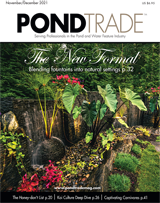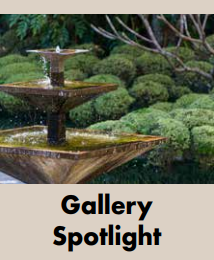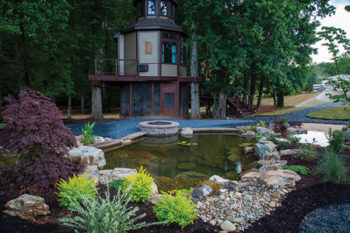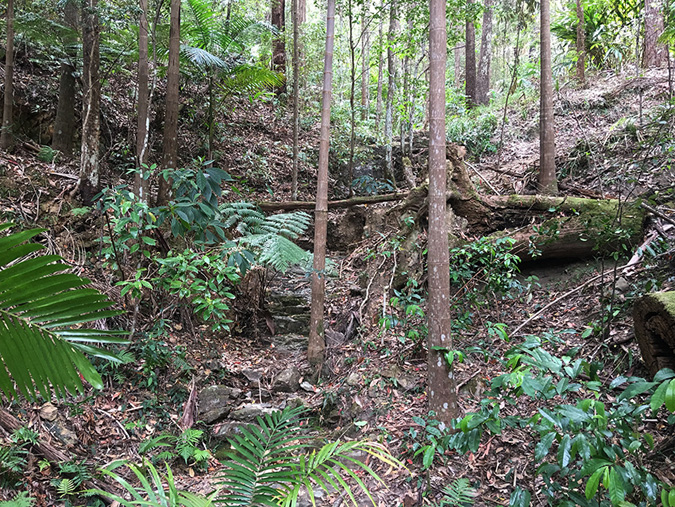
We were approached by the Mistere Spa and Retreat to transform a dry, seasonal gully into a lush, continuously flowing water course. With an emphasis on creating a grand backdrop for the perfect wedding photo, this had to be something pretty special.
Just a stone’s throw from iconic Byron Bay with panoramic views of Mount Warning in New South Wales, Australia, this amazing property was ideally located for the retreat’s wedding functions for national and international visitors. The existing lake, the centerpiece of the property, had great potential but lacked the “wow” factor necessary to set the area off.
There were some key points to consider in the design. We were to construct a 45-meter (150-foot) waterfall and stream working with bedrock areas and an existing rock wall. There were high water-flow and erosion risks in the wet season, but it would be dry throughout most of the year. We designed a 9-meter (29.5-foot) head delivery with pipe friction loss. The clay-lined lake would adversely affect pumps placed directly into it. Variable flow would be required at the flick of a switch, so the client could change the ambience from a gentle cascade to a spectacular waterfall. Finally, the steep slope and difficult access would require the construction of a purpose-built road to the site, which would limit the size of machinery we could safely operate there.
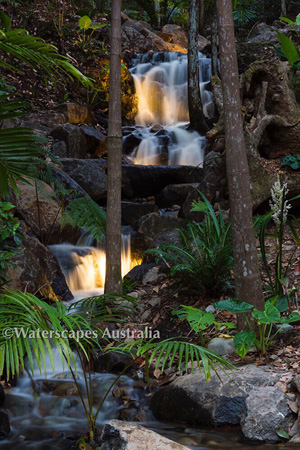
We were intrigued by the challenge and very eager to see the vision come to life, so we got to work.
To make the cascade look natural and have that “always-been-there” feel, we had to get the right rock. The predominant stone in the area is a volcanic basalt, and as there were no local suppliers of suitable weather stone, the 60 tons of basalt boulder was delivered by our regular source 190 miles away.
The gully was excavated carefully with certain areas of the existing bedrock left in place. In particular, the main fall was left entirely as carved by nature, needing just a small helping hand to direct the water flow as we wanted.
We utilized concrete cloth within the excavated gully to keep the water flowing on the desired course and stop floor erosion and washout. In our experience, we have found that liner is unsuitable for existing waterways, as it will bulge due to water buildup from below and wash out when there is a substantial rain event that brings natural flow from the slope above. Concrete cloth is an excellent solution, and we recommend its use in these situations.
Larger-sized, 45- to 300-mm (2- to 12-inch) river pebble was installed over the concrete cloth to naturalize and stabilize the stream floor between the boulder.
With a 6-ton excavator, each rock was strapped and placed. The water’s pathway was strategically dammed and directed with the overall vision in mind — a natural, mountain stream that turns and bounces down the slope, becoming a gentler rainforest pebble stream.
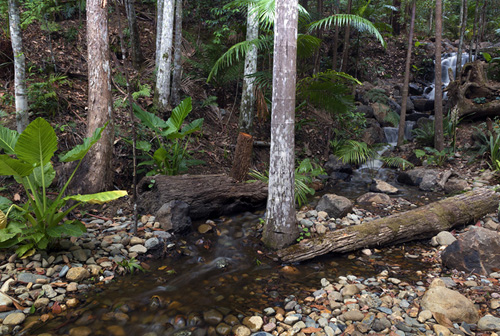
A large concrete weir and intake bay were constructed at the far end of the existing lake. They were designed to not only handle the required water flow, but also structurally withstand the flooding in the notorious northern New South Wales wet season and be adjustable to skim at the varying water levels in the drier times. Three Tsurumi 3-phase submersible pumps were installed in Aquascape Snorkel Vaults.
At the 13-meter (42.7-foot) total dynamic head, including the pipe friction losses, these provide a total of nearly 130,000 liters (35,000 gal) per hour, and when individually switched, they supply controllable flow rates for the cascade and the dam’s circulation jets. Submersible pumps were essential to avoid the noise factor of an external pump setup — after all, this was supposed to be a tranquil retreat.
The water was delivered to the head of the waterfall with three runs of 90-mm (3.5-inch) poly pipe, with each run 100 meters (328 feet). It was a bit of a challenge maneuvering those lengths through the Australian bush. Aquablocks were used to disperse and spread the pipe outflow, and the water now appears to flow naturally from under boulders at the stream head. The local landscapers were impressed by this simple detail.
To really set the mood, we spent an evening installing a range of Aquascape LED spotlights. We prefer subtle lighting and got in close to highlight the best features of the design.
When the moment arrived, with great anticipation we stood back and flicked the switch. As the water made its way down, backing up at each new cascade before pushing its way over them, excitement and relief followed, knowing the “wow” factor was definitely there! The client is mesmerized with the end result, and we have since been asked to design another feature on the 100-acre property.

We learned a lot on this installation. It was the first large-scale Aquascape intake bay installed in Australia in a clay-lined dam, and this provided us with confidence for future projects. The individual flow rates of each pump were documented, so we can now better visualize the results and determine how rock placement and waterfall structure react in larger designs.
We also learned that when calculating the sizes of rocks for larger streams of 1.5 to 2 meters (4.9 to 6.6 feet) wide, we should allow for 1.8 tons per linear meter (1,209 pounds per foot) of actual stream edge to be rocked. Also, concrete cloth is a winner when constructing in existing waterways. Finally, we learned that in the logistics of bulk material on a site with limited storage and access, you should maintain strong communication channels with your supplier throughout the project.
Needless to say, there are a lot more photos to come, with the addition of established plantings and the occasional happy couple.




